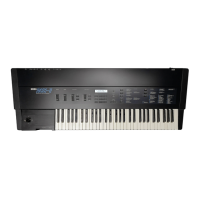■ The sounds assigned to the keyboard in this mufti-
sound were obtained by sampling and then trun
cating to remove the unneeded portions of the sampL
ed sounds- This is the usual procedure when attemp
ting to reproduce acoustic instrument sounds. The
sounds should be looped if the instrument sound that
you are trying to recreate has long sustain or is con
tinuous. The loop is not needed if the goal is the
recreation of a short, rapidly attenuated sound*
■ Here we have waveforms created by additive syn
thesis or hand drawing. Each wavelength is half
again as long as the previous one, so each can be
neatly assigned to an octave and looped. This works
like the sound sources in a conventional analog syn
thesizer* With waveforms containing complex har
monics and with sine waves, it is a good idea to
assign sounds to the lower reaches of the keyboard
to avoid noise and distortion in that region when pitch
is transposed downward by a large amount.
However, with square and sawtooth waveforms, the
same short sound can be used for the whole key
board.
* Sounds with loop on. (Long loop or short loop.)
• Sounds with loop off.
■ Here we have a multisound that contains sounds
sampled at different frequencies and sounds created
by additive synthesis and/or hand drawing. These
have been edited and assigned to different portions
of the keyboard.
On the DS5-1, it doesn’t matter how you obtain the
sounds in a multisound* You can assign up to 16
sounds of any kind to the keyboard in any one multi
sound.
Sampled sound using
16kHz sampling fre-
Sounds made by hand
quency.
Sampled s(
48kHz sarr
quency.
drawing.
Dund using
pling Ire-
r
------
^
Sound made by linking
sounds created by additive
synthesis, producing tim-
braJ variation over time.
— - [
\ r \ j \ r \ S K s
%
A
m
44

